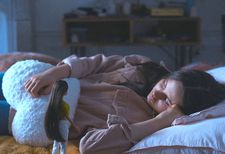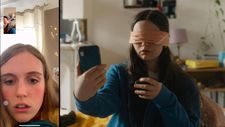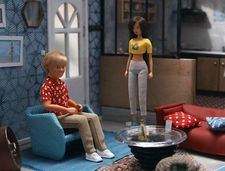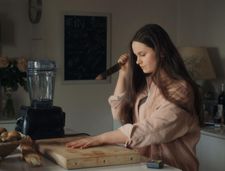Bertrand Bonello’s prophetic Coma (with a haunting score by the director/screenwriter), starring Louise Labèque (of Zombi Child) as the adolescent and Julia Faure (from The Beast, La bête, with Léa Seydoux and George MacKay) as the title character Patricia Coma, was filmed in France during the Covid pandemic lockdown. We hear the voices of Gaspard Ulliel (Yves Saint Laurent in Bonello’s Saint Laurent), Anaïs Demoustier, Laetitia Casta, Louis Garrel, and Vincent Lacoste as the dollhouse figures. We see Romy Schneider’s face in a camera test for Henri-Georges Clouzot’s unfinished Inferno (L’Enfer) and meet a woman in the forest portrayed by Bonnie Banane (whose video Champs-Élysées, featuring Walter Mecca, is seen in Bonello’s Nocturama, as pointed out to me by music producer and 99 Records founder Ed Bahlman).
 |
| Young girl (Louise Labèque) with Sharon doll in Coma |
Theorists Gilles Deleuze, Jacques Lacan, Jacques Derrida, and how well they connect with childhood play turn up in our conversation, as well as quotes by Emil Cioran, Winston Churchill, and from The Gospel According to St. Matthew by Pier Paolo Pasolini.
“Do not surrender to our present moment,” is good advice. The present time in Coma, as Bertrand Bonello so poignantly explored in his Henry James inspired The Beast, is always connected to past and future. Patricia Coma, online guide and ghostly mistress of limbo, does weather reports [too hot to go out anywhere], quotes Cioran, sells a toy called the Révélateur, which proves that free will does not exist, and a blender for the kitchen in which your vegetables always stay raw and self-harm is optional.
Beware of being caught in someone else’s dream said Deleuze, a warning that is strictly ignored in Coma, where we are entering the dreamscapes of a young girl (Louise Labèque) with the pandemic lockdown as background. The film begins with a letter we read in subtitles, written by the director to his own daughter as a kind of follow-up to Nocturama, which had also been dedicated to her. While the 2016 film was cut in half, with one aspect of the binary story informing the other, time and place are even more fluid here.
“Our survival depends on our capacity to lie to ourselves” says Coma, and gives updates on which countries “will be eliminated” [Brazil and the entire African continent are already gone, and France is headed there too, this very second, whatever that entails]. There are dolls voiced by French movie stars, a clip of light on Romy Schneider’s face from the never finished L’Enfer, music and dance for trapped souls in a forest limbo, serial killer confessions, teenage Zoom calls (that include some of the Zombi Child cast), a laugh reel and much more.
 |
| Patricia Coma (Julia Faure) forecasting dire weather in Coma |
From Paris, during the Cannes Film Festival, Bertrand Bonello joined me on Zoom for an in-depth conversation on his two latest films, Coma and The Beast.
Anne-Katrin Titze: Good to see you again!
Bertrand Bonello: Hello!
AKT: When we spoke about Zombi Child, Legba came up, the deity of the in-between. Wile watching Coma, I thought about Legba again. The movement between spheres is there as well. Do you see that?
BB: Yes, of course it’s even more obvious in a way. The word limbo is used quite a lot in the film and we actually spend some time in the limbos. And there is something, like in Zombi Child, between life and death, day and night, you know. Except that in Zombi Child it’s a simple story, here it’s more inside the brain of a young girl. You don’t know exactly what’s real and what’s not. It’s everything that happens in her mind; dreams or nightmares, she creates different worlds and we are going from one to another. In the beginning the worlds are quite separate, then after a while they contaminate each other.
AKT: It was interesting to rewatch Coma after The Beast. Elements were falling into different places for me. Especially the Deleuze quote “Beware of other people’s dreams, because if you get caught then you’re finished.” That is the case in the Henry James story [The Beast In The Jungle, his 1903 novella which inspired Bonello] for the woman, more so actually than in your film. Tell me more about the Deleuze quote!
 |
| Léa Seydoux with George MacKay in The Beast |
BB: In fact, well first of all about the relationship between the two films, it is true that I was ready to shoot The Beast in 2021 and mainly because of Léa Seydoux’s schedule we had to postpone the film to shoot in 2022. I had a whole year in front of me blank, and my producer said, do you want to do a short movie just to get busy? I said, no, let’s do a feature but with the budget of a short movie.
So of course when I started to write Coma, writing, prep, shooting was all very quick. I had in mind The Beast, I was waiting to shoot The Beast and I think that’s why there are some relationships between the films, even when the subjects are very very different. There are relationships in mixing different types of images, different types of worlds. So I was maybe trying out unconsciously some stuff with this film.
AKT: And the Deleuze quote?
BB: It’s a sentence which I really love because you can give it many meanings. I don’t know exactly what Deleuze meant when he said that. It was related with Vincente Minnelli’s films.
AKT: Was it in the context of Minnelli films in general or a specific one?
BB: In general. It’s from a conference he did at La Fémis, the film school. I just took it first degree when I was trying to find how to get into the story. With this quote it’s very easy. You know that - it comes pretty early in the film - that you are going to enter the dreams of a young girl. He says “Don’t enter!” And the film just disobeys.
 |
| Romy Schneider in Henri-Georges Clouzot’s unfinished L’Enfer (Inferno) |
AKT: Now that you say it was in the context of Minnelli, I am thinking of Brigadoon and the time shifts involved in it. Cinema does move us easily into different times. You are kidnapping us.
BB: Yeah, and cinema is amazing for dreams and nightmares. Either it’s really dreams or nightmares, or it’s that you’re twisting reality and it becomes dream or nightmare. Cinema is made for that.
AKT: The quote can also be taken in relation to a love story, Vertigo is the prime example. In The Beast there is also a wanting to enter into somebody else’s dream.
BB: Yes, in different ways, but basically it’s the same. Entering what’s inside you. In The Beast it’s past lives. Here it’s more unconscious. To escape reality in a way in both films with two different ways.
AKT: The Zoom call between the girls about their fascination with serial killers feels quite realistic. I was talking with my students [at Hunter College] not long ago and suddenly Jeffrey Dahmer came up and they were having a most lively conversation about him, it surprised me. The name of the girl on Zoom being kidnapped is Tess - were you thinking of Thomas Hardy?
BB: Ha, no, you are giving me more intention than I had. When the film came out people asked me about this Zoom sequence and if it’s improvisation. It’s not, it’s very written, every word. In Coma I was trying to put some very common images and make them become cinema images. Zoom is part of our lives, it’s very common, but if you think about it and really prepare it very well it can become a cinema scene. In fact it’s like a huge sequence shot with seven cameras. It’s very very precise, all the dialogue and everything.
 |
| Salomé (Adilé David), Romy (Ninon François), and Adèle (Mathilde Riu) with Fanny (Louise Labèque) in Zombi Child |
AKT: Can you tell me more about the light on Romy Schneider’s face?
BB: I was trying to find an image that you could dream of when you’re a young girl. What I like about this image is that of course it’s very magical, there’s Romy Schneider and in a way it’s a film that does not exist, you know?
AKT: Yes! [It is test footage for Henri-Georges Clouzot’s L’enfer]
BB: It’s just camera tests, it’s not real, it does not exist. So it’s something more that is unreal in a way.
AKT: Right before our conversation I was on a Zoom call with the Italian director Roberta Torre on her film Mi Fanno Male I Capelli [the title about the hair hurting is taken from Antonioni’s Red Desert] that is inspired by, but clearly not a biopic of Monica Vitti. Torre uses costume tests with Monica Vitti in her film, which makes it, in your words, also almost a film that does not exist. With the music and sound design you always take us somewhere else from the get-go. At the start of Coma we hear a speech muffled in Italian, what is that?
BB: It’s The Gospel According to St. Matthew from Pasolini. It’s the Christ talking.
AKT: Oh, there’s another layer! Christ talking! Is that also back at the end?
BB: Yes.
 |
| Our dreamer (Louise Labèque) on Zoom with Tess (Ninon François) in Coma |
AKT: The film turns less anthropocentric near the end. Humans disappear, nature takes over again, we read another letter. There is destruction and rebirth perhaps and a disappearance of humans.
BB: Yeah, I really wanted to end with a second letter and images of nature and catastrophe and something quite sensual at the same time to say these last words which are quite pessimistic but with a light at the end in which I really believe. The way I play with images, music, sounds and the writing of the letter - you’re trying to find a sensation. It’s like a piece of music with images.
AKT: Covid is the background of this film, as well as the belief that spring will come again. Are you familiar with Oscar Wilde’s The Selfish Giant?
BB: No, I don’t know this one.
AKT: It has a Christ figure and is about isolation and there are personified seasons. One very good piece of advice you give in Coma is “If you are going through hell, keep going!” I love that!
BB: It’s not me who said that, it’s Winston Churchill!
AKT: The Révélateur, that is not Winston Churchill?
BB: That is not Winston Churchill! We wanted to put in the film the concept of free will because I think about that a lot. But I didn’t want to go through philosophical questions or stuff like that, so I liked pretty much the idea of going through a game, a cheap game, something made of plastic, and to talk about all these complicated concepts. Doing it more funny, with a game.
 |
| Scott (voiced by Gaspard Ulliel) with Sharon (voiced by Laetitia Casta) in Coma |
AKT: It has a Rubik’s Cube look to it a bit.
BB: Yeah, and it reminds me of a game from my childhood in France called Simon [Electronic Memory Game], in which you have to remember all the colours and stuff like that.
AKT: I think my favourite edit is right before the Deleuze clip when the protagonist sits down at her doll’s house. I realised something for myself that I never thought of before, namely a similarity in feeling between playing as a child with my dolls and discovering theory, theorists, reading Lacan or Deleuze or Derrida. There was an emotional connection that I wasn’t aware of before, so thank you for that! I don’t know if that makes sense to you.
BB: It does, of course, of course! Mixing dolls and free will, all these concepts. I wanted to feel free in this film to mix a lot of things. To make a pop film with some strong thoughts inside of it. Of course, if you want to be free, you have to work very hard so the construction is very precise. The biggest work is in the construction to be able to welcome all these different worlds.
AKT: The free zone is the limbo land in Coma and in The Beast the club is called Free Zone.
BB: Yes, in a way it’s the same thing - it’s a place in which things are allowed. You can do things there that you cannot do in other places for different reasons in the two films. In Coma because there’s a lack of freedom in real life, so in the limbo, even if it’s dangerous, you can feel free. And in The Beast, there’s so much loneliness in 2044 that you have this place in which you can meet people and just throw everything out. I like spaces that are in-betweens.
AKT: And there’s Legba again.
BB: Yes!
 |
| Bertrand Bonello on Coma: “Mixing dolls and free will, all these concepts. I wanted to feel free in this film to mix a lot of things.” |
AKT: Concepts of time and the reversal of time are central to the character of Patricia Coma. Messages remain unsent and still arrive, that’s maybe why Lacan came to mind. The cooking session - she makes a soup but the vegetables remain raw. The time reversal idea is also present in The Beast.
BB: Yes, in very different ways, but in both films you lose sense of time. Which is something I really liked to do for a few films now, even in House of Tolerance or Nocturama you lose sense of time. For me when I found the character of Patricia Coma it was amazing because you can do so many things with her, you know?
She starts as a YouTuber girl, basic, doing weather-reports or selling machines for cooking. She looks very strong and then at one moment she starts to humanise herself and to be so melancholic. At the beginning of the film you think she’s like a real YouTuber girl and after a while you ask yourself if she really exists or is in the mind of the young girl.
AKT: She starts out by quoting Emil Cioran - don’t kill yourself because it’s always already too late. And then moves on to the extreme weather. While writing my notes for our talk today, I wrote down 5/20/25, which means I moved us a year into the future. Which I think is quite fitting.
BB: Perfect!
AKT: Thank you so much!
BB: Thanks a lot! Thank you very much!
The Beast is released on May 31 in the UK through Vertigo Releasing and currently is on selected release in the US through Sideshow and Janus Films. Coma is in cinemas in the US.
- Read further thoughts from Bertrand Bonello on sci-fi, loneliness, music and working with Léa Seydoux






















